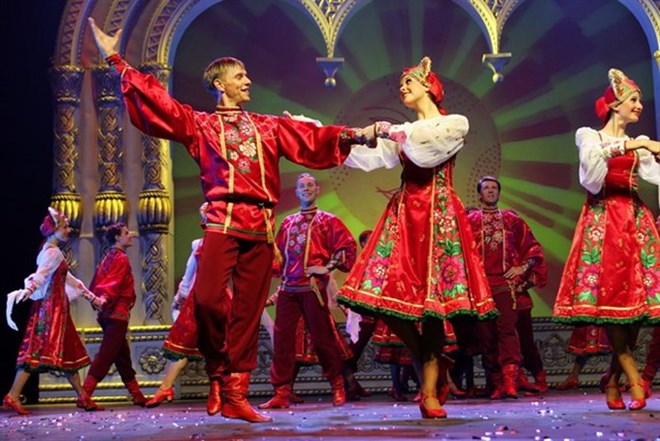
An art programme titled "October Epic” will be held at the Vietnam -Russia Culture Palace in Hanoi on November 1.

Historic: Russian actors and actresses will perform at
a concert in Việt Nam to celebrate October Revolution (File photo)
The programme will
celebrate the 100th anniversary of the Russian October Revolution (1817-1917),
said organisers from the People’s TV Station.
The event will include Russian songs that have become familiar to the
Vietnamese people, such as "Russia My Homeland”, "Kalinka” and a number of
Russian ballet and orchestra works. They will be performed by artists from both
countries, including Quang Tho, Lan Anh, Khanh Ly and many artists from Russian
art troupes.
Many local and international experts will exchange views on the history of the
Russian October Revolution and Vietnam’s August Revolution.
One such expert is Moscow radio journalist Aleksei Syunnenberg Lensov, who has
made tireless efforts in collecting identities of Russian and Vietnamese Red
Armies who fought for the Soviet Union during World War II. Vietnamese soldiers
included Ly Nam Thanh, Ly Anh Tao and Ly Thuc Chat from the central province of
Nghe An, who were killed during a fight against the Nazi at the Moscow gate.
Apart from the programme in Hanoi, concerts of Russian love songs
will held early this November by VOH Music One in HCM City.
The programme will include renowned singers such as Tran Hieu and Cam Van.
It also aims to promote the relationship between Vietnam and Russia and enhance
communications between businesses from the two countries.
Images and music at the concerts will remind audiences of the two countries’
decades of memories and close ties, the organisers said.
Audiences will not only enjoy Russian music but also meet Russian people.
Songs to be performed will include "My Fatherland Russia”, "The Ural’s Rowan”,
"Kachiusa”, "Moscow’s Suburb PM” and many others.
A Russian Culture Week will also be held from October 30 to November 5 at the
theatre. The week will display paintings by Russian painters and cultural
publications.
The concerts will be held on November 2, 3 and 4 at VOH Music One Theatre, 37
Nguyen Binh Khiem, Dakao ward, District 1, HCM City.
Source: VNA
With an increasingly vibrant and widespread emulation movement aimed at building cultured residential areas and cultured families, Yen Thuy District has been making steady progress toward improving both the material and spiritual well-being of its people, while fostering a civilized, prosperous, beautiful, and progressive community.
Once lacking recreational spaces and community facilities, Residential Group 2 in Quynh Lam Ward (Hoa Binh City) has recently received attention for the construction of a new, spacious, and fully equipped cultural house. The project followed the model of state support combined with public contributions in both labor and funding.
The "All people unite to build cultural life" movement, which has been effectively integrated with Kim Boi district’s socio-economic development goals, is fostering a lively spirit of emulation across local residential areas, hamlets, villages, public agencies, and enterprises. In addition, through the initiative, traditional cultural values are being preserved and promoted, while community solidarity and mutual support in poverty reduction and economic development are being strengthened.
A working delegation of the Hoa Binh provincial People’s Committee led by its Permanent Vice Chairman Nguyen Van Toan on June 11 inspected the progress of a project to build the Mo Muong Cultural Heritage Conservation Space linked to tourism services in Hop Phong commune, Cao Phong district.
Born and growing in the heroic land of Muong Dong, Dinh Thi Kieu Dung, a resident in Bo town of Kim Boi district, in her childhood was nurtured by the sweet lullabies of her grandmother and mother. These melodies deeply imprinted on her soul, becoming an inseparable part of her love for her ethnic group's culture. For over 20 years, this love for her hometown has driven Dung to research, collect, and pass down the cultural values of the Muong people to future generations.
In the final days of May, the Ethnic Art Troupe of Hoa Binh Province organized performances to serve the people in remote, mountainous, and particularly disadvantaged areas within the province. These were not just ordinary artistic shows, but they were the meaningful journeys aimed at spreading cultural values, enhancing the spiritual life of the people and contributing to the preservation of ethnic minority cultural identities.



